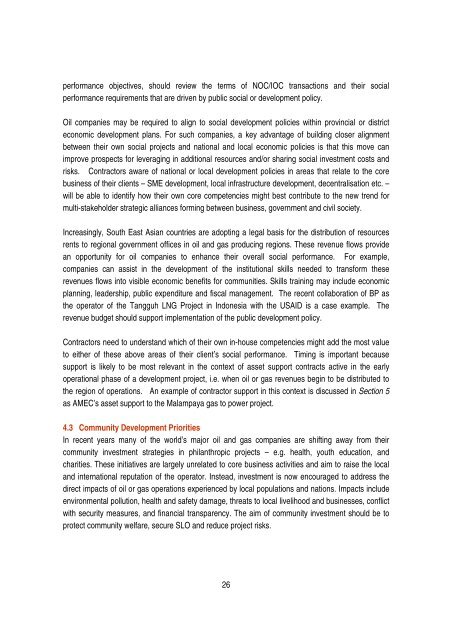Learning from AMEC's Oil and Gas Asset Support ... - CommDev
Learning from AMEC's Oil and Gas Asset Support ... - CommDev
Learning from AMEC's Oil and Gas Asset Support ... - CommDev
- No tags were found...
You also want an ePaper? Increase the reach of your titles
YUMPU automatically turns print PDFs into web optimized ePapers that Google loves.
performance objectives, should review the terms of NOC/IOC transactions <strong>and</strong> their socialperformance requirements that are driven by public social or development policy.<strong>Oil</strong> companies may be required to align to social development policies within provincial or districteconomic development plans. For such companies, a key advantage of building closer alignmentbetween their own social projects <strong>and</strong> national <strong>and</strong> local economic policies is that this move canimprove prospects for leveraging in additional resources <strong>and</strong>/or sharing social investment costs <strong>and</strong>risks. Contractors aware of national or local development policies in areas that relate to the corebusiness of their clients – SME development, local infrastructure development, decentralisation etc. –will be able to identify how their own core competencies might best contribute to the new trend formulti-stakeholder strategic alliances forming between business, government <strong>and</strong> civil society.Increasingly, South East Asian countries are adopting a legal basis for the distribution of resourcesrents to regional government offices in oil <strong>and</strong> gas producing regions. These revenue flows providean opportunity for oil companies to enhance their overall social performance. For example,companies can assist in the development of the institutional skills needed to transform theserevenues flows into visible economic benefits for communities. Skills training may include economicplanning, leadership, public expenditure <strong>and</strong> fiscal management. The recent collaboration of BP asthe operator of the Tangguh LNG Project in Indonesia with the USAID is a case example. Therevenue budget should support implementation of the public development policy.Contractors need to underst<strong>and</strong> which of their own in-house competencies might add the most valueto either of these above areas of their client’s social performance. Timing is important becausesupport is likely to be most relevant in the context of asset support contracts active in the earlyoperational phase of a development project, i.e. when oil or gas revenues begin to be distributed tothe region of operations. An example of contractor support in this context is discussed in Section 5as AMEC’s asset support to the Malampaya gas to power project.4.3 Community Development PrioritiesIn recent years many of the world’s major oil <strong>and</strong> gas companies are shifting away <strong>from</strong> theircommunity investment strategies in philanthropic projects – e.g. health, youth education, <strong>and</strong>charities. These initiatives are largely unrelated to core business activities <strong>and</strong> aim to raise the local<strong>and</strong> international reputation of the operator. Instead, investment is now encouraged to address thedirect impacts of oil or gas operations experienced by local populations <strong>and</strong> nations. Impacts includeenvironmental pollution, health <strong>and</strong> safety damage, threats to local livelihood <strong>and</strong> businesses, conflictwith security measures, <strong>and</strong> financial transparency. The aim of community investment should be toprotect community welfare, secure SLO <strong>and</strong> reduce project risks.26















![[PDF] Community Development Toolkit - CommDev](https://img.yumpu.com/48616495/1/184x260/pdf-community-development-toolkit-commdev.jpg?quality=85)
